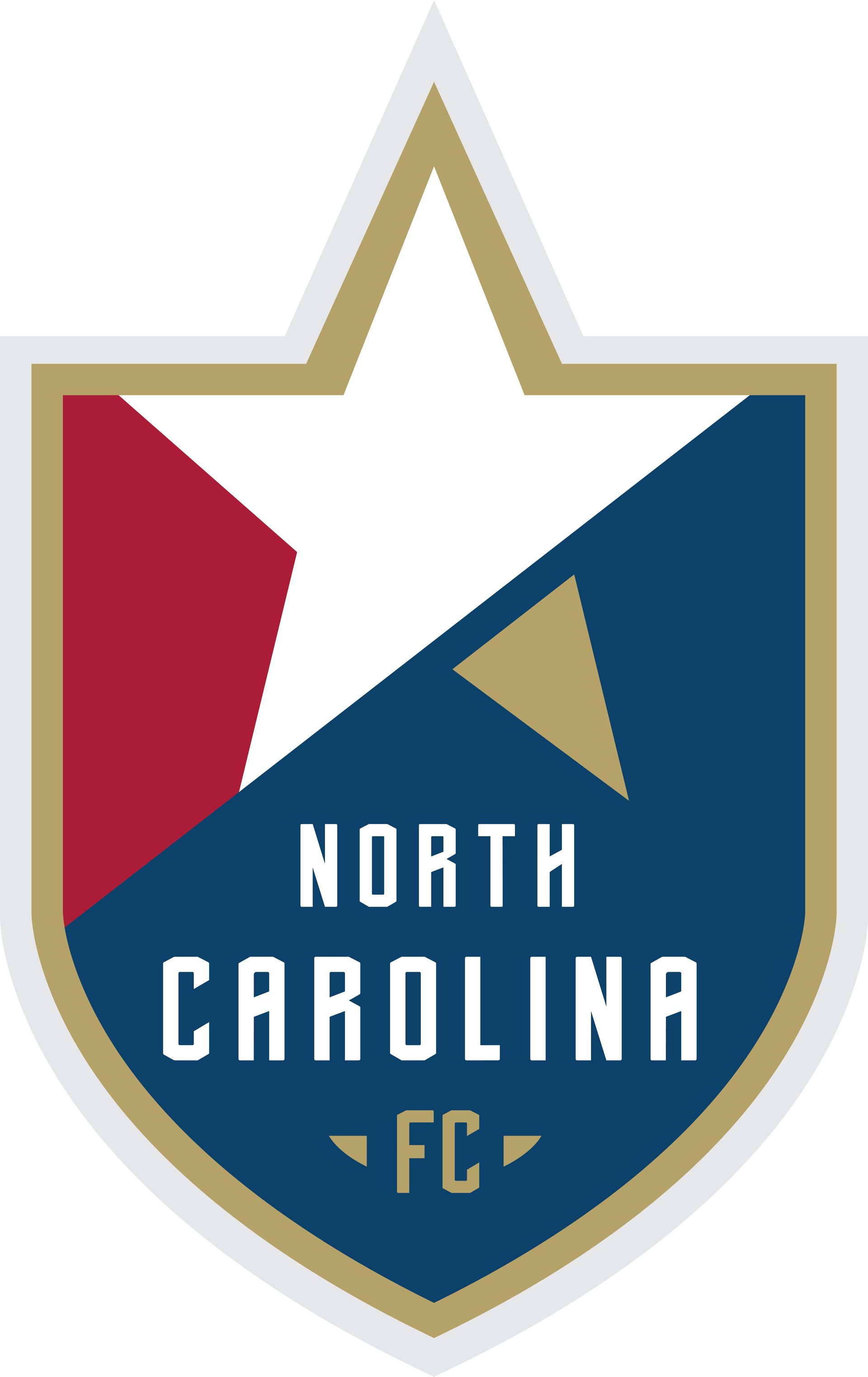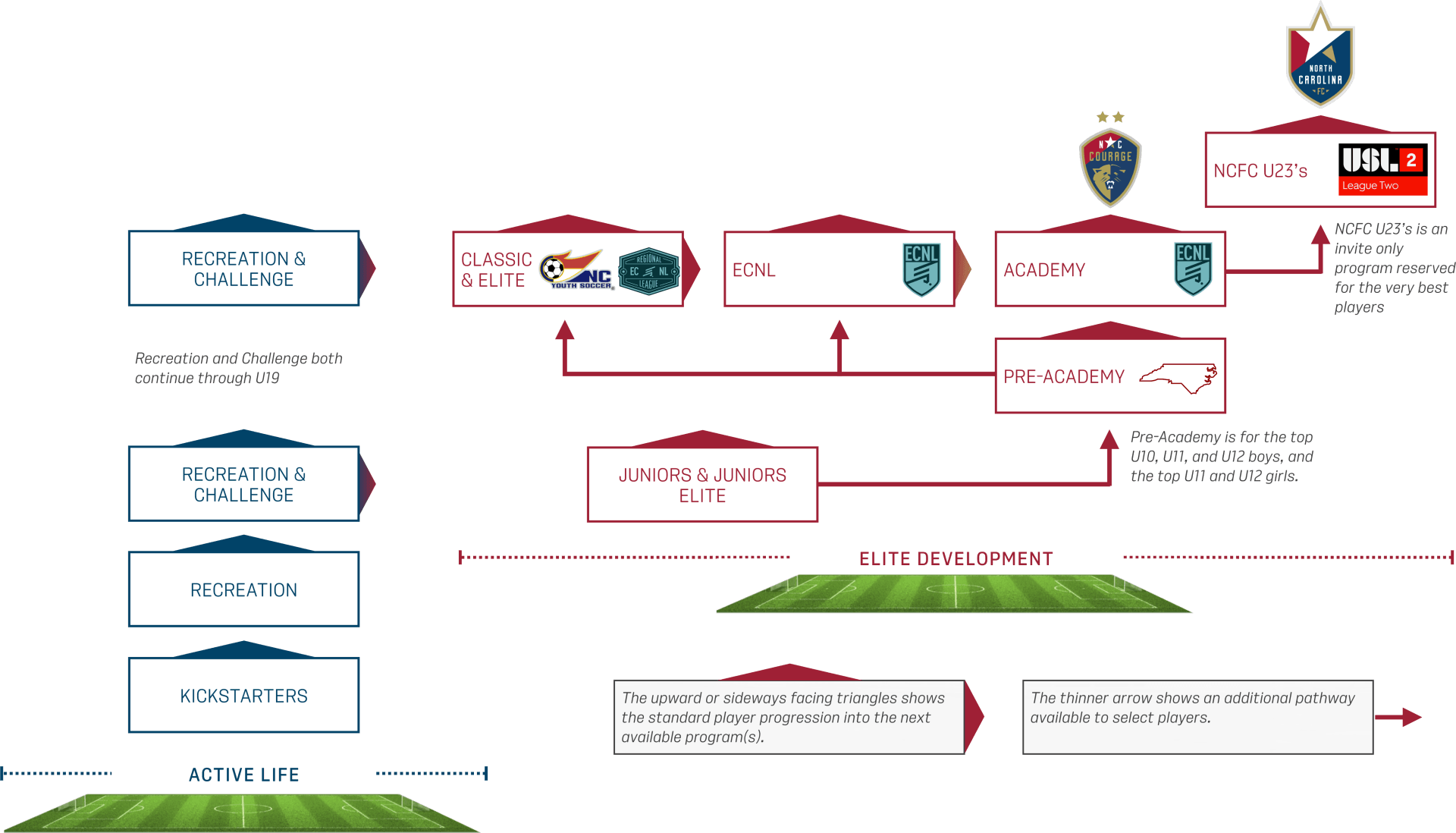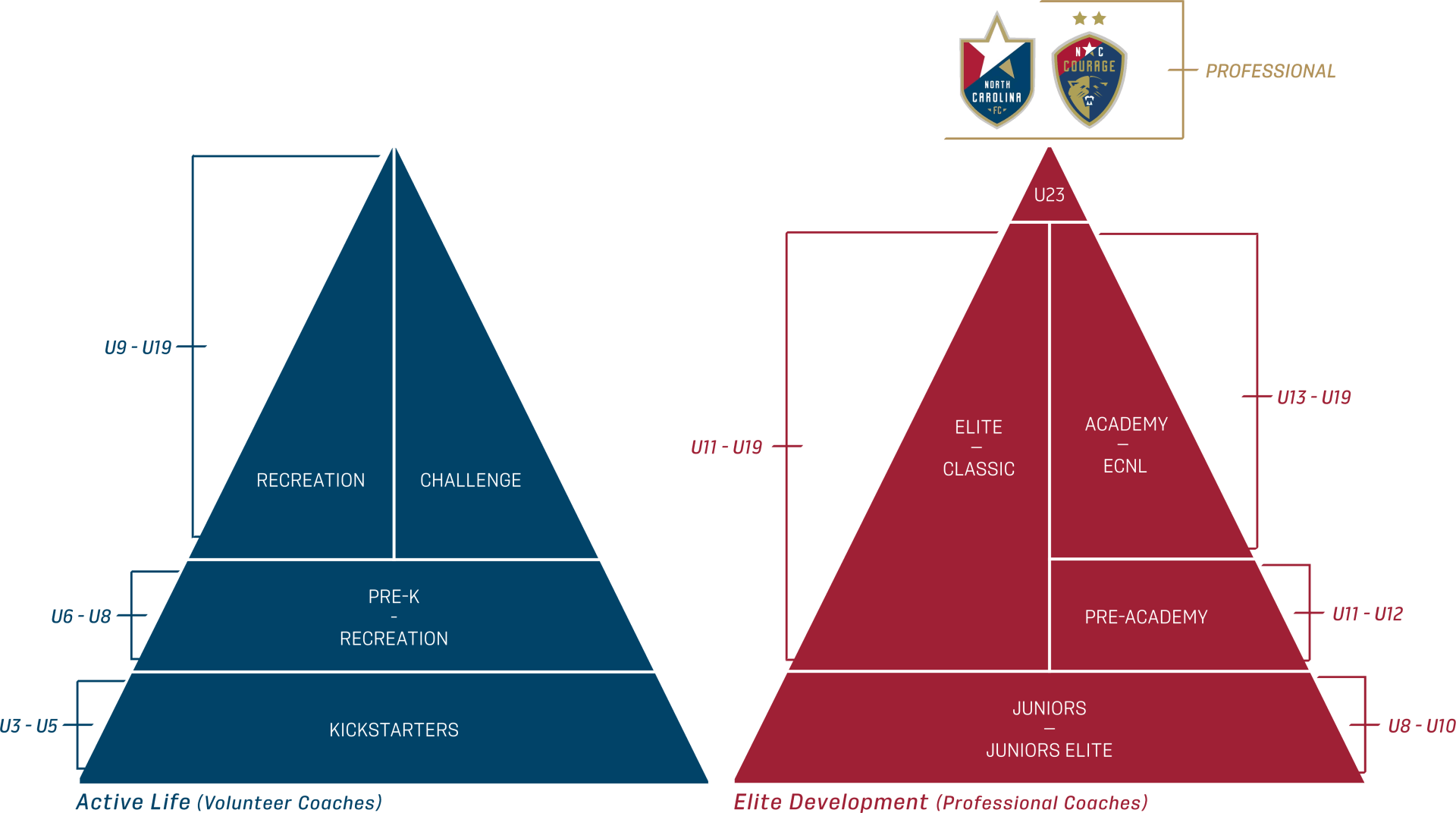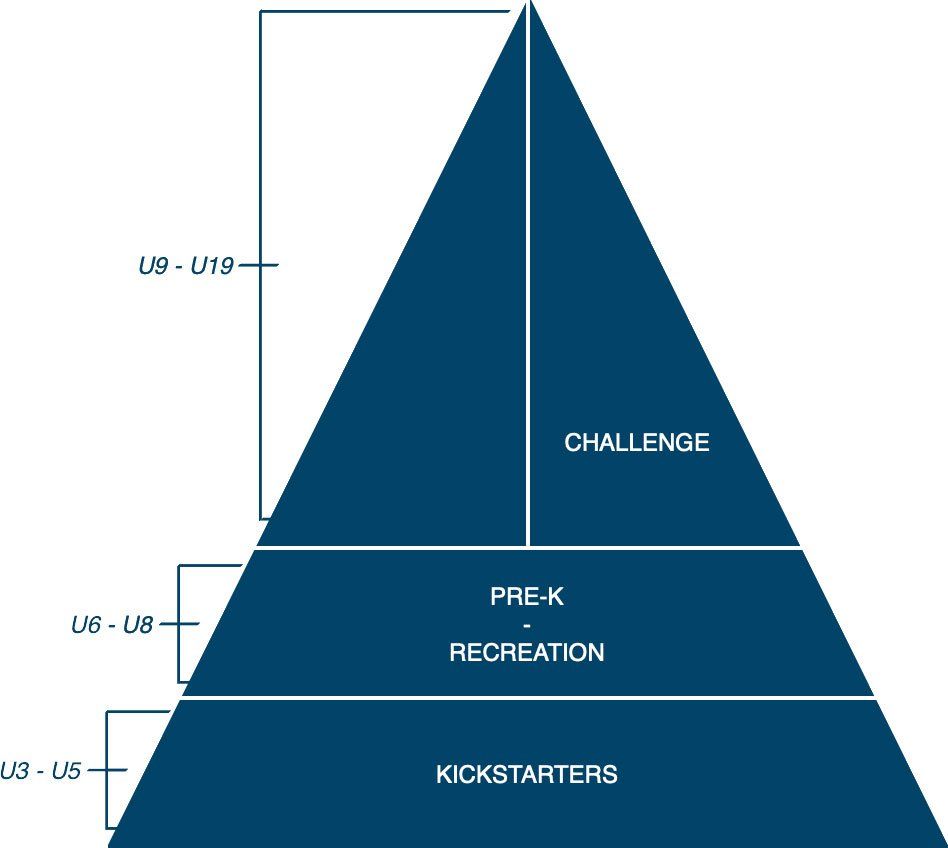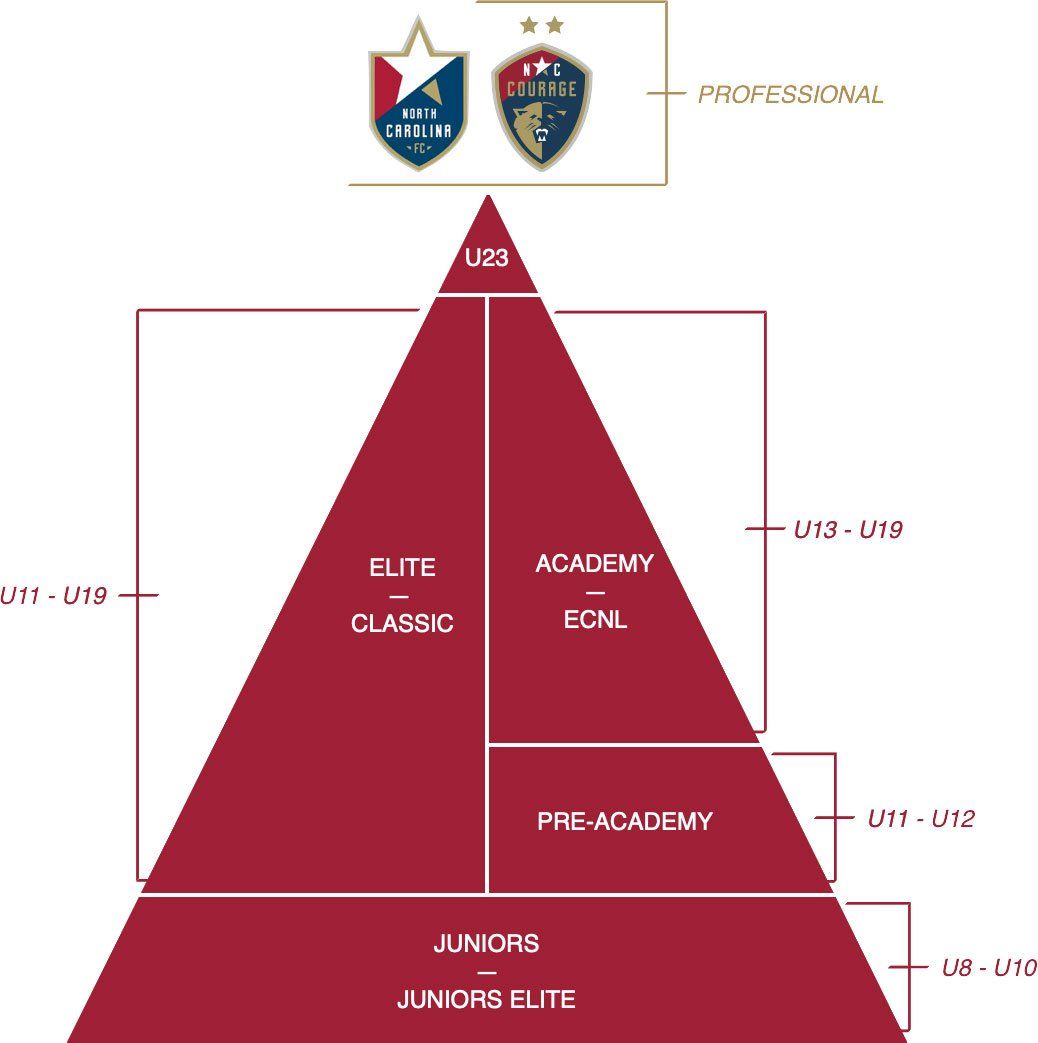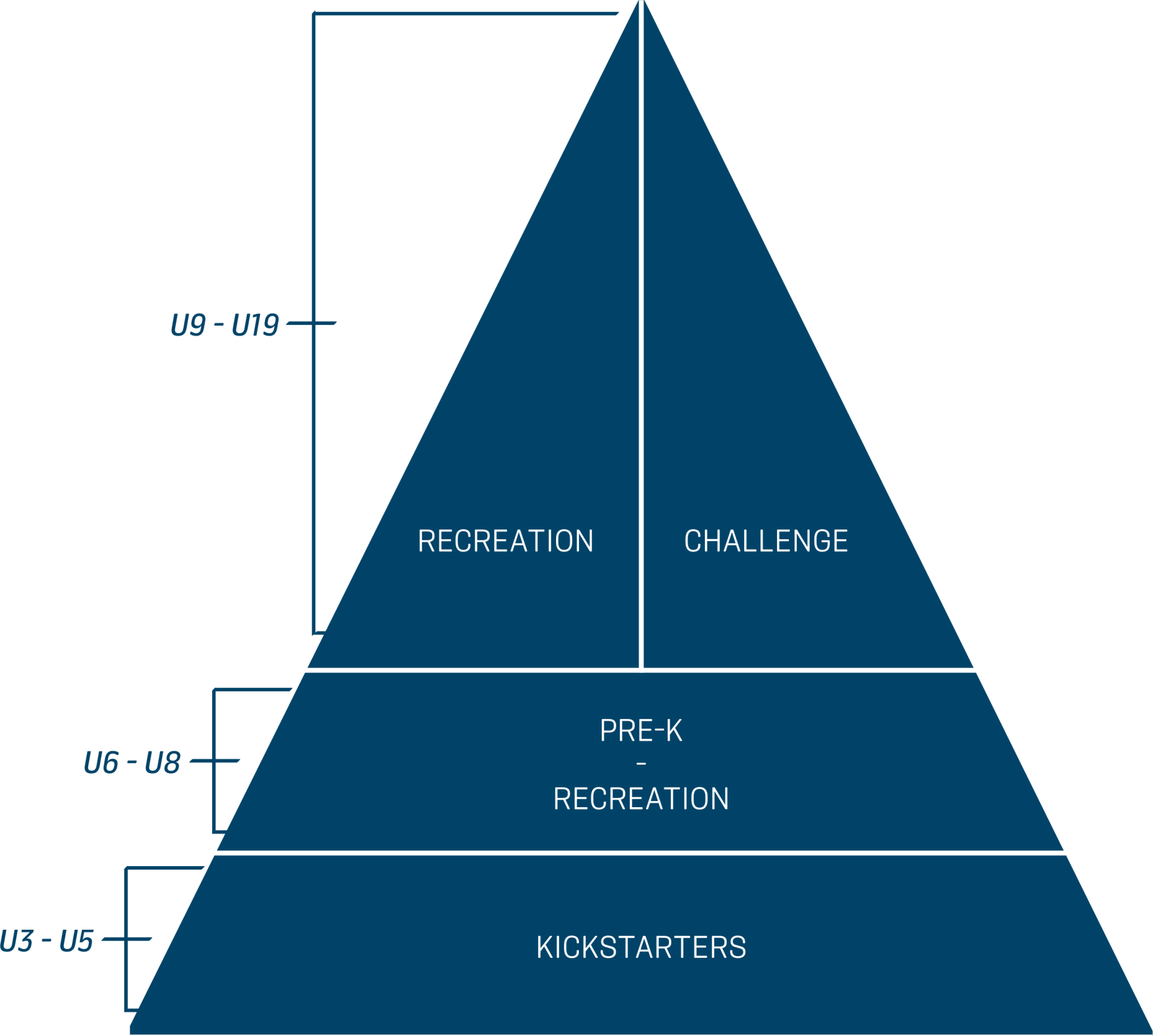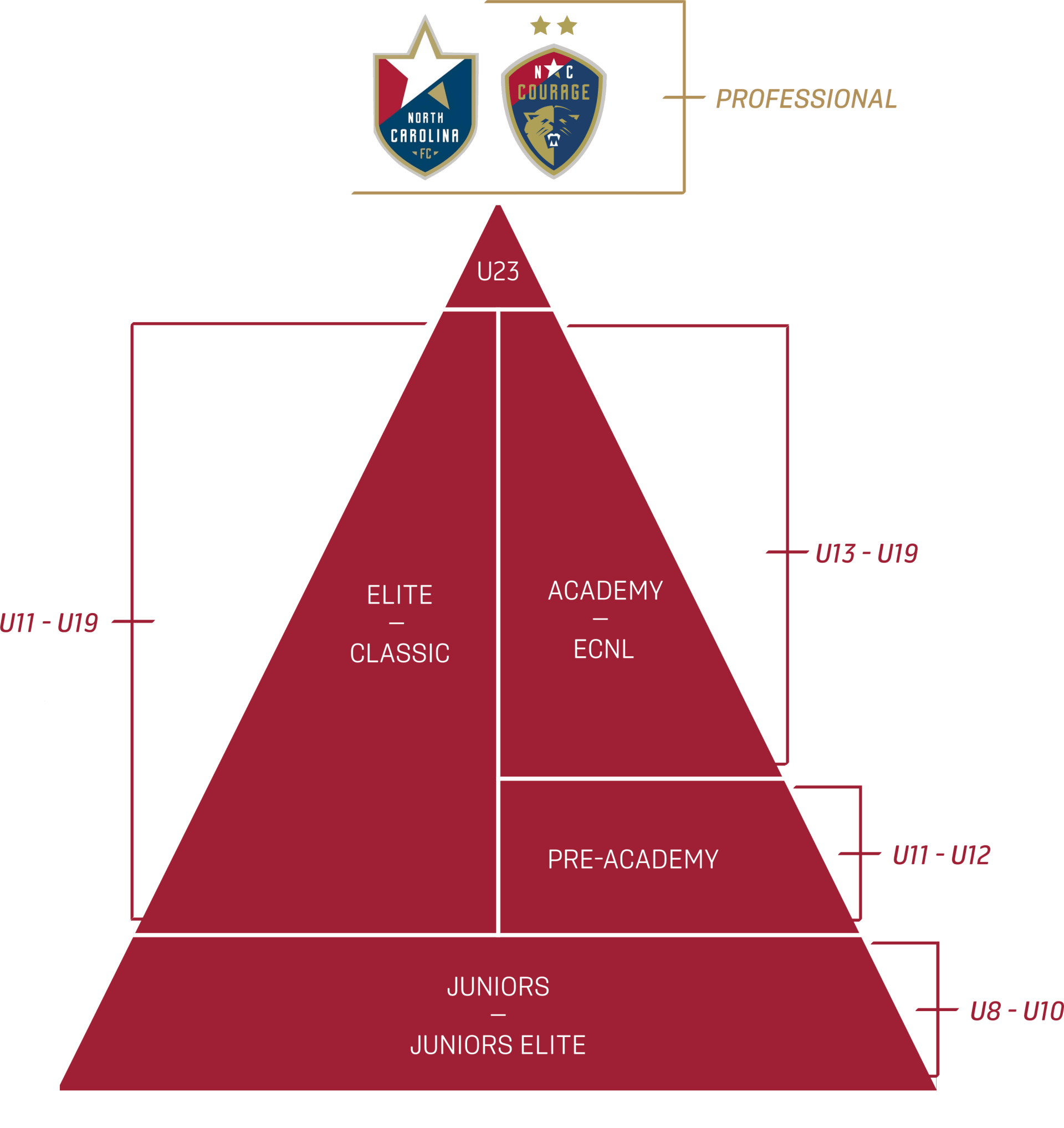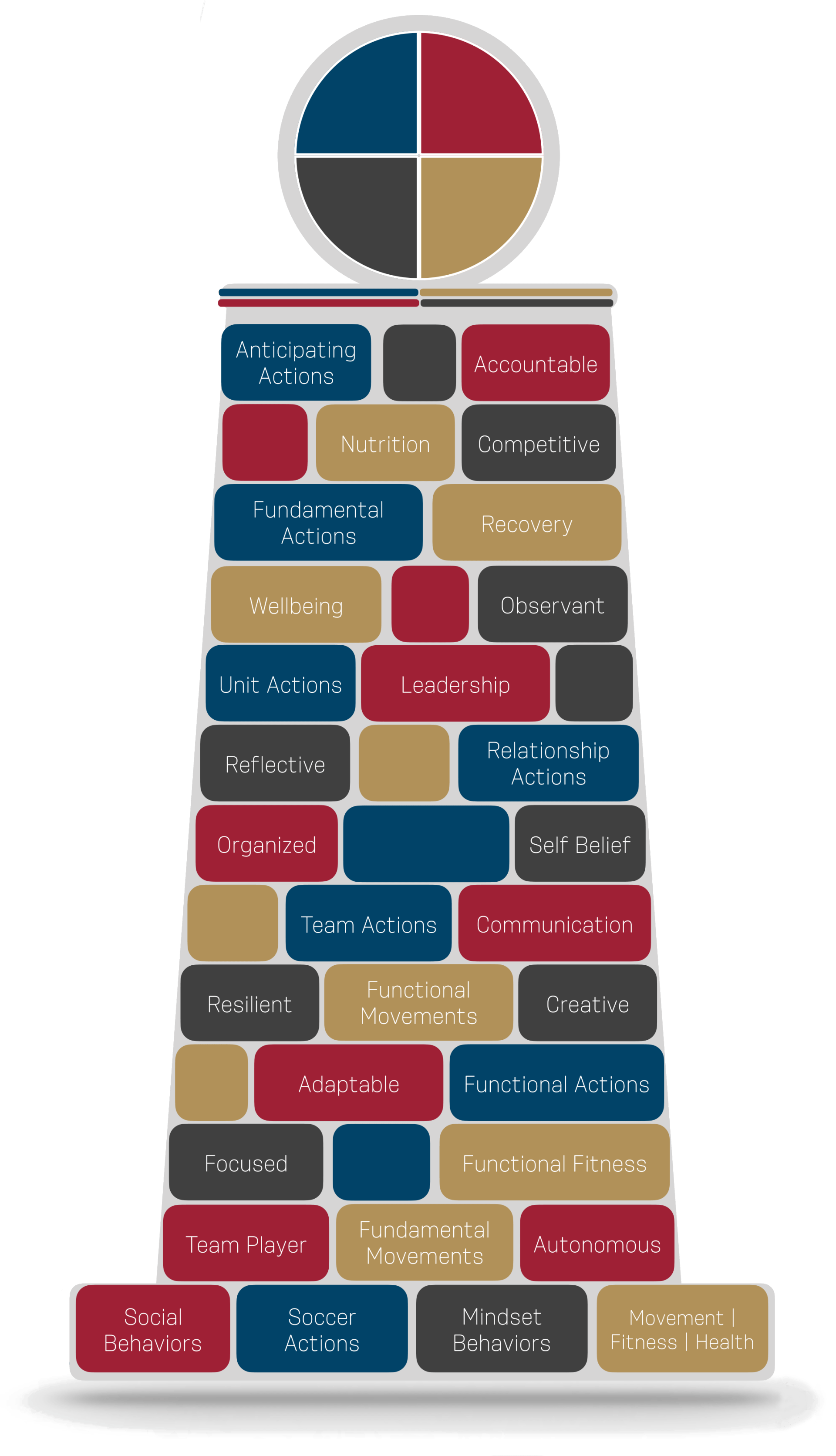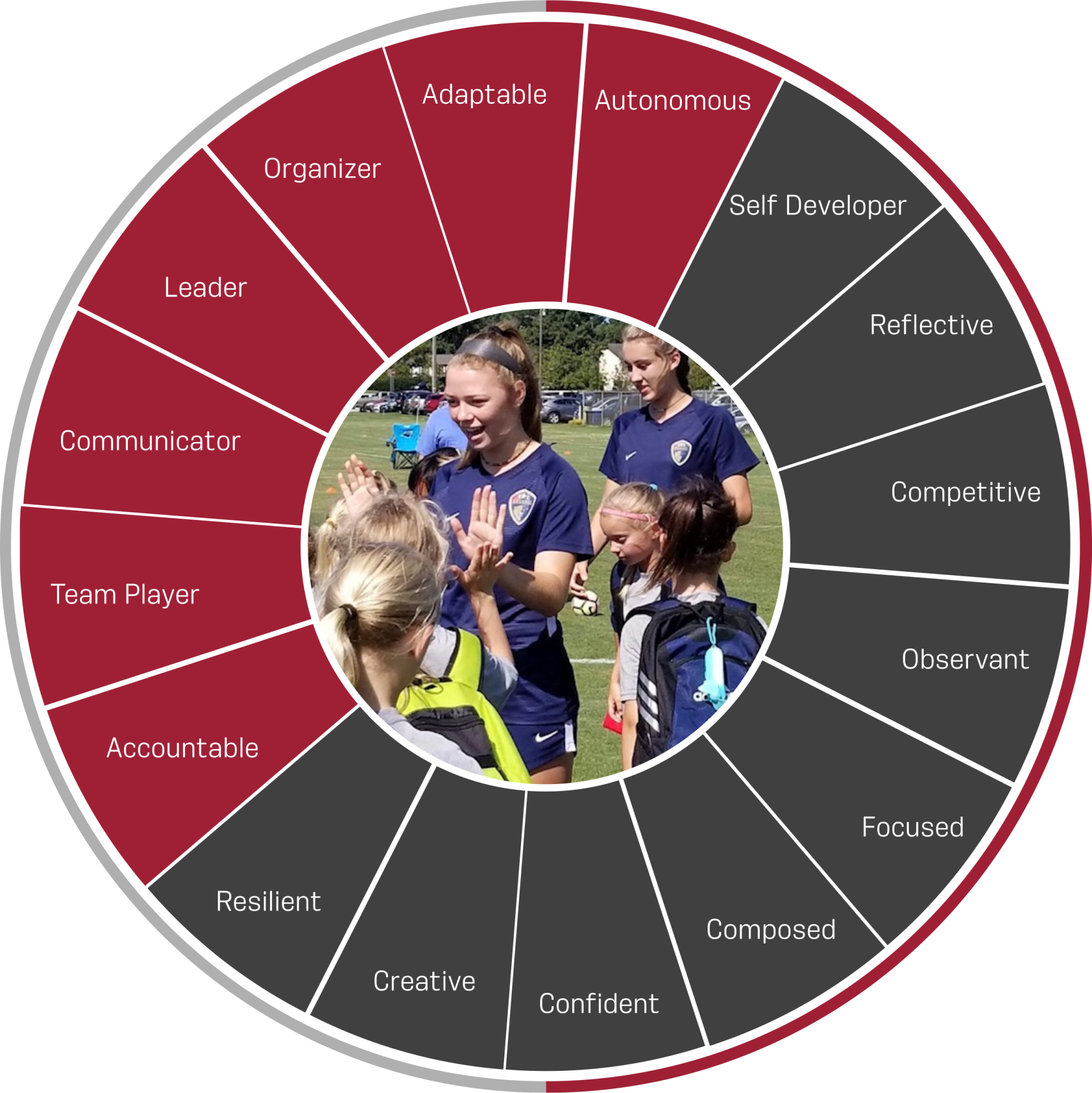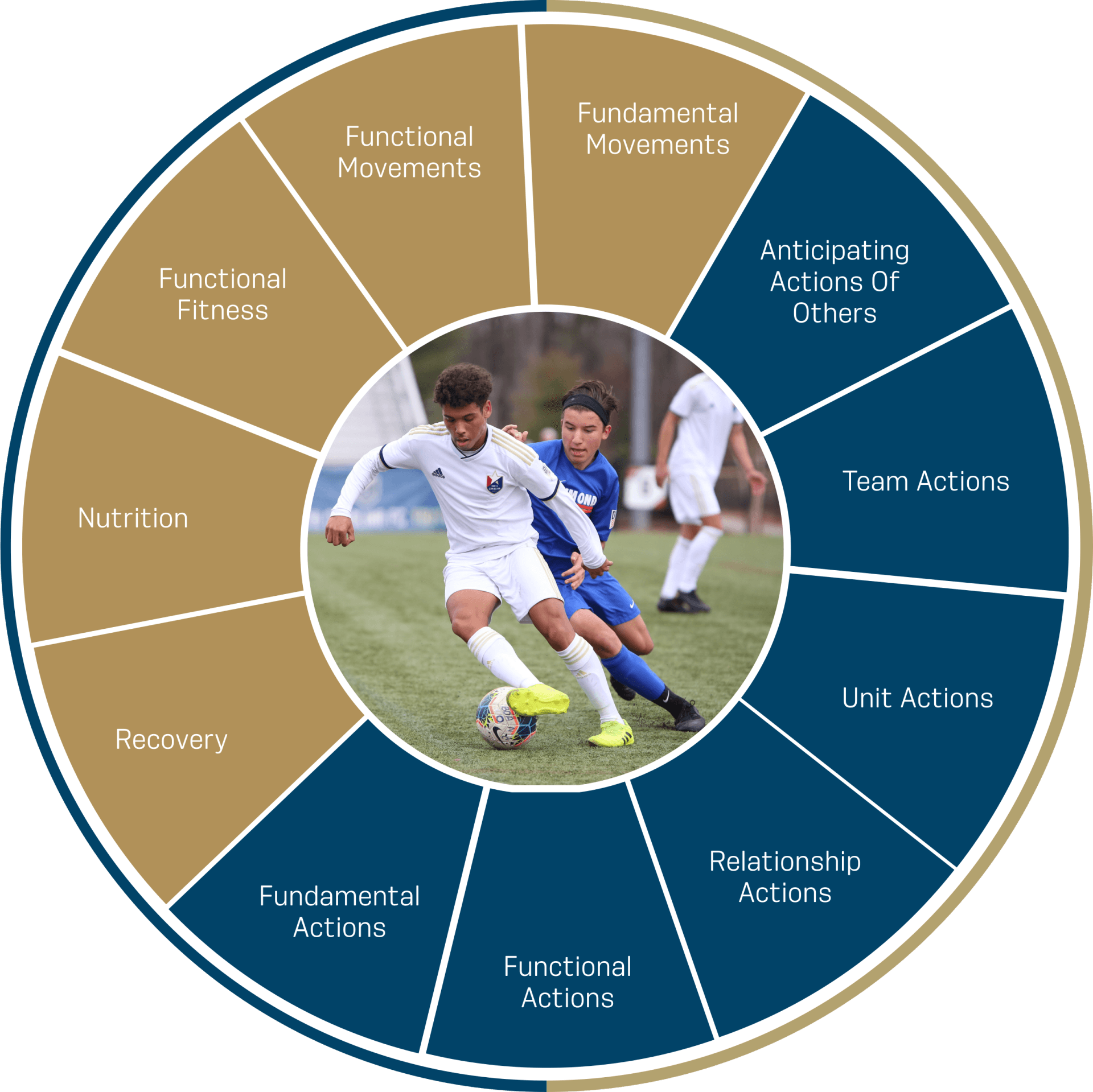PLAYER PATHWAYS
Player Pathways
Our club accommodates and provides pathways for players at all levels of interest and ability. Our aligned and cohesive framework meets the needs of all our players. It provides a clear distinction between the development phases and the various ability and interest levels. We support smooth transitions between each stage, including increased support to players that aspire to play at the collegiate and professional levels.
Development Phases and Programs
Our player's progress through our club follows four phases. Each phase has a variation in approach as players naturally experience physical, psychosocial (Erik Erikson), and cognitive (Jean Piaget) growth.
Our development approach in each stage is to teach actions within the game's situational context and thus create realistic scenarios in which the players learn.
As players progress from 1v1 to 11v11, the number of available choices for each decision they have to make increases. Using Hick's Law, we ensure that players have an appropriate amount of choices for the duration of time they have in their given situation.
Development Platforms
We have two development platforms for our players, each offering various programs that allow us to cater to every player, regardless of ability or commitment. Each platform has the same holistic approach to development, with players being able to move between them in either direction.
Active Life Programs
Our objective is to provide players of all ages a place to play, stay active, and enjoy time with friends while learning the game. All programs aim to provide a fun and challenging environment for players. At U8, players can continue their development towards excellence and move into the Elite Development platform.
Kickstarters
(Players aged between 2½ and 4 years old)
For our youngest players, this is an introductory, recreation program that focuses on physical literacy with and without the ball in a fun and positive social environment.
Pre-K/Recreation
(Players aged between 5 and 19 years old)
Players focus on developing the fundamental requirements of the game in a continued, positive, and fun environment. This program is all in-house.
Challenge
(Players aged between 8 and 19 years old)
A step up from our recreation program, players are offered the opportunity to commit more of their time to their development. This program is in-house; however, teams do compete in various tournaments.
Elite Development Programs
The objective is to provide an environment for players to compete and focus on individual and team development with a long-term vision towards becoming an elite player in either a professional or collegiate setting. Players possess an increased ability level and a higher commitment to their personal development.
Juniors/Juniors Elite
(Players aged between 7 and 10 years old)
This is our first program that exposes our players to professional coaches. The environment is focused on developing fundamental and functional movements and soccer actions.
Classic/Elite
(Players aged between 10 and 19 years old)
These programs are our entry point for players that desire a more competitive league and training environment (and potentially aiming to make one of our elite programs). High school age players train and compete with their respective schools during the high school season and with our club for remaining.
Pre-Academy/ECNL/Academy
(Players aged between 10 and 19 years old)
These are our elite programs for our players that are the most advanced in their soccer development.
Our Academy program is the highest level available to our players. Here we focus on preparing our players to eventually graduate into the professional ranks.
Our ECNL program sits just below the Academy and is generally comprised of two types of players.
- Players that are focused on making the step to the Academy.
- Players that want to compete in their high school program. These players train and compete for their respective high school program during the school season, and then return to full-time training with our club
Building Lighthouses
Develop The Person and Develop The Player
Why a lighthouse? Lighthouses are a symbol of strength; they're a guiding light in the darkness and always looking out for the people around them. They're built to last; strong and resilient. They're focused, reliable, and always ready to help. They do not complain, nor crumble under pressure. They instead, stand tall and ready to act.
When graduating from our club, players should be equipped with all the tools and education to make a positive contribution to society and future generations. They are the lighthouses of their environment, and we strive to build every day.
To do this, we have four pillars of development that house what we believe are the required qualities and characteristics to build a lighthouse.
Social Behaviors
We are a multicultural club and must constantly create environments where players can develop the ability to self-regulate in social settings, form relationships, be accepting, and considerate to the feelings of others. Players should understand how to control their emotions and behavior and develop their ability to communicate effectively with peers and authoritative figures in various settings.
Mindset Behaviors
Our primary aim is to help each player establish and develop healthy, appropriate beliefs and attitudes towards life, sports, and soccer. Through soccer, we’re focused on developing people and players who have a growth mindset and can be successful on and off the field.
Soccer Actions
Using our game principles, we aim to develop the player’s technical execution and link it directly to the tactical decision required for the situation. Doing so means we are putting the actions into CONTEXT. When players understand WHAT to do and WHY to do it, they are more likely to become adaptable and autonomous.
Movement | Fitness | Health
Our aim is to develop each player to have a positive attitude toward health and wellbeing, fitness, and recovery. We focus on fundamental and functional movements in the early years to develop comprehensive physical literacy. As players grow, our focus shifts to the functional actions and the specific fitness attributes that players require to play at their age and level.
Developing the Person
The attributes listed below are what we believe defines the type of people we are trying to be and develop:
Social Behaviors
- Autonomous
- Accountable
- Adaptable
- Team Player
- Communicator
- Leader
- Organizer
Mindset Behaviors
- Self Development
- Competitive
- Observant
- Focused
- Composed
- Confident
- Creative
- Resilient
- Reflective
Developing the Player
We develop driven, autonomous, and adaptable players by focusing on the components listed below. These are progressive steps and are introduced at various stages of player growth.
Soccer Actions
- Fundamental Actions
- Functional Actions
- Relationship Actions
- Unit Actions
- Team Actions
- Anticipating Actions of Others
Movement, Fitness, Health
- Fundamental Movements
- Functional Movements
- Functional Fitness
- Nutrition
- Recovery



